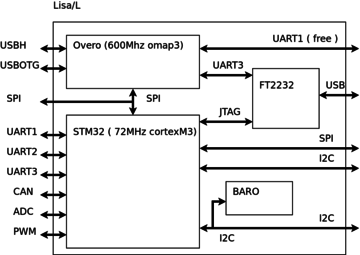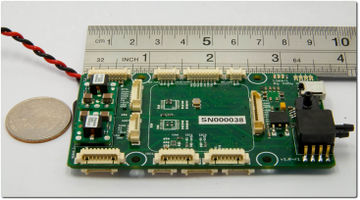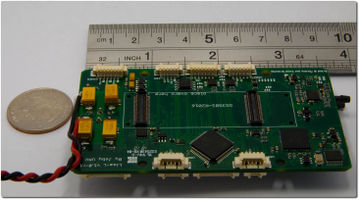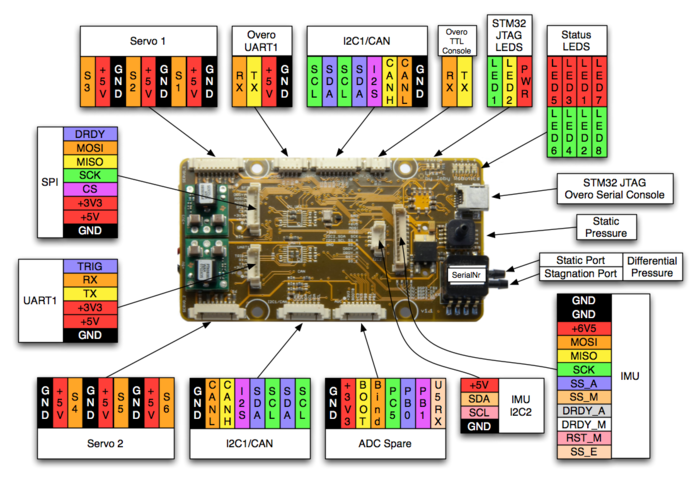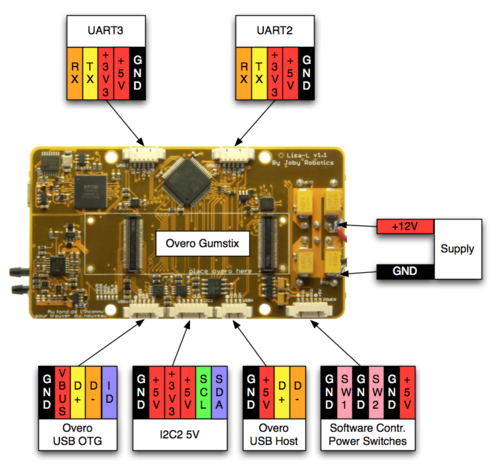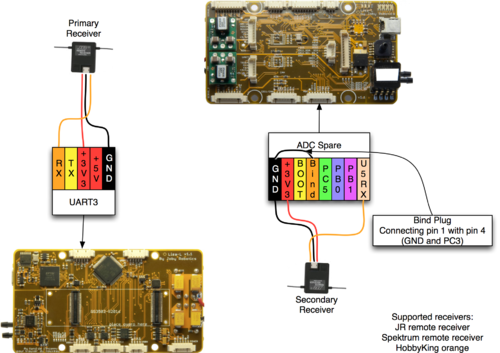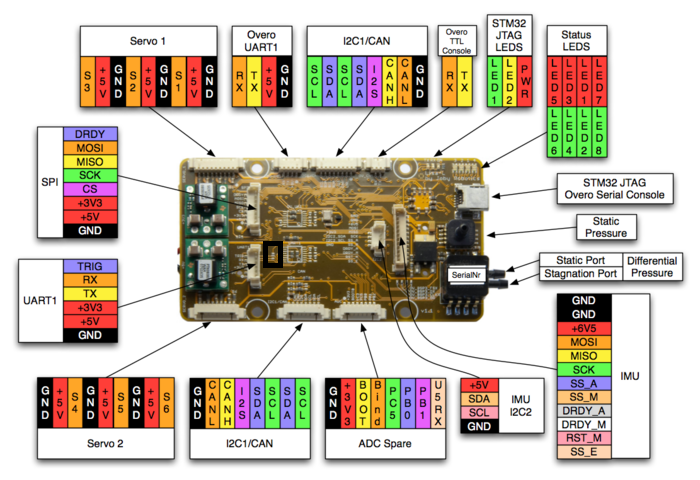Difference between revisions of "Lisa/L"
m (→Overo) |
(added link to stm32 datasheet) |
||
| Line 29: | Line 29: | ||
= Features = | = Features = | ||
* STM32 microcontroller (CortexM3@72Mhz) | * STM32 microcontroller (CortexM3@72Mhz) [http://www.st.com/internet/com/TECHNICAL_RESOURCES/TECHNICAL_LITERATURE/DATASHEET/CD00191185.pdf STM32F103RE datasheet] | ||
* ?x Analog input channels 0V - 3.3V (2 channels with optional on-board resistor bridge) | * ?x Analog input channels 0V - 3.3V (2 channels with optional on-board resistor bridge) | ||
* 3x 3.3V TTL UART (5V tolerant) | * 3x 3.3V TTL UART (5V tolerant) | ||
Revision as of 08:05, 24 December 2011
This page describe how to use Lisa/L from a user point of view
Lisa/L
Lisa ( the Lost Illusions Serendipitous Autopilot) is a new range of autopilots based on STM32 microcontrollers ( CortexM3@72Mhz ) designed to run Paparazzi. There's no such thing as a perfect autopilot, only autopilots adapted to a particular purpose. This is the reason why Lisa comes in different flavors for different usages.
Description
Lisa/L is a dual processor board autopilot designed to allow the possibility of using Linux for Paparazzi airborne code.
Hardware Revision History
| Version # | Release Date | Release Notes |
|---|---|---|
| v1.00 | ??? | Initial release of Lisa/L |
Features
- STM32 microcontroller (CortexM3@72Mhz) STM32F103RE datasheet
- ?x Analog input channels 0V - 3.3V (2 channels with optional on-board resistor bridge)
- 3x 3.3V TTL UART (5V tolerant)
- 1x CAN
- 6x PWM outputs
- 1x R/C receiver PPM frame input (trig pin on UART1 connector)
- 2x SPI bus
- 2x I2C bus
- ?x USB (client)
- ? switching power supply
- ? linear regulator
- ?x status LEDs with attached test point
- ? grams (? oz)
- dimensions
- 4 layers PCB design
Getting started
- Install Gnu/Linux Ubuntu and the paparazzi-dev, paparazzi-arm-multilib packages and paparazzi-omap( Installation from the Command Line: on this page Installation ).
sudo apt-get update sudo apt-get install paparazzi-dev paparazzi-arm-multilib paparazzi-omap
- Connect power to the board. The board accepts input voltage from 6V to 18V. The power connector is from JST and known in the rc world as a BEC connector
- Connect a mini USB cable in the mini USB connector. This should give you two USB devices. The first one ( usualy /dev/ttyUSB0) is the console for the Overo, the second one is the JTAG for the STM32
- Flash a test program in the stm32 :
make AIRCRAFT=BOOZ2_A7 test_baro.upload
Overo
- The main documentation page for the overo on gumstix website is here.
- We now have a Overo toolchain package ! install the paparazzi-omap package.
sudo apt-get install paparazzi-omap
If you feel it's too easy, you can look at here and enjoy the fun of compiling openembedded yourself
- In order to use the SPI link between the STM32 and the Overo, you'll need a patched linux kernel and a couple of libraries. Look in the developer section if you wanna know the gore details of it. If not, just download our pre-compiled filesystem image and kernel from here and follow the instruction from here to write them on a micro sd card.
When you want the files to be downloaded en written on the SD do:
cd ~/sw/tools/overo_sd_maker/ sw/tools/overo_sd_maker sudo ./overo_sd_maker.sh
- Once you have written your OS image to the sd card, you may insert it in the Overo and power Lisa. Connecting a mini usb cable to it will give you access to the console of the Overo as the first USB device ( usualy /dev/ttyUSB0). You can run a terminal like gtkterm or kermit to watch your Overo booting and log on it using root for login and no password.
Install the Kermit application via:
$ sudo apt-get install ckermit
Then start up Kemit terminal application do:
$ kermit -l /dev/ttyUSB0 C-Kermit>set flow-control none C-Kermit>set carrier-watch off C-Kermit>set speed 115200 /dev/ttyUSB0, 115200 bps C-Kermit>connect Connecting to /dev/ttyUSB0, speed 115200 Escape character: Ctrl-\ (ASCII 28, FS): enabled Type the escape character followed by C to get back, or followed by ? to see other options.
When you wait a few minutes your overo is booted from the SD card and you can log in if you see overo login:
overo login: root root@overo:~#
- One on the first things you might want to do is setup wireless networking. Overo Air has a builting wifi adapter. On others you can use an external USB wifi stick.
- Flash the STM32 with the link test program
make AIRCRAFT=BOOZ2_A8 stm_test_spi_link.upload
- Compile and upload the Overo test program.
make AIRCRAFT=BOOZ2_A8 overo_test_spi_link.upload
- Log on your Overo and run it
Use case #1: the fixedwing firmware running in the STM32 only
Coming soon... look for airframes/AirborneCodeReorg/LisaFw.xml
Use case #2: the rotorcraft firmware running in the STM32 only
Use the airframes/Poine/booz2_a7 as an example. You may only have to change some subsystems type to match your peripherals.
make AIRCRAFT=BOOZ2_A7 ap.upload
Use case #3: the lisa_passthrough firmware
This firmware is about turning the STM32 into a simple io processor that sends sensors and radio control to the Overo and fetches actuators position in return.
The stm_passthrough target is what is ran on the STM32.
The overo_test_passthrough target demonstrates the use of the Paparazzi framework on the Overo: communications with the stm32, accurate periodic events and telemetry/datalink over wifi.
IO
Lisa-L 0.99 LED order:
green: 3, 5, 7, 1 red: 2, 4, 6, 0
Spektrum/JR remote receiver connection diagram
PPM Remote receiver
To use the PPM signal of a PPM remote receiver, the input pin for the signal is the Trig.pin 1 (on UART1 connector), it is hardcoded and can not be changed. Also make sure that a bridge(~0 Ohm) in the conductor path is soldered. See below picture for the right position.
